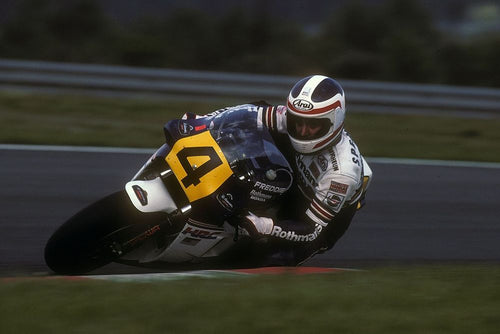
1204 mots | Temps de lecture : 6 minute(s)
Husaberg, the Swedish motorcycle brand that revolutionized the industry
Welcome to the fascinating world of Husaberg , a Swedish motorcycle brand that has made history in the off-road industry with its innovative approach and passion for excellence . Founded on the spirit of forward-thinking engineering , Husaberg has always pushed the boundaries of technology and performance . Let's discover together the rich history of this company, marked by challenges , innovations and resounding successes .
The origins of Husaberg
It all started in 1988 , when a group of talented engineers , former Husqvarna employees , decided to create their own motorcycle brand after Husqvarna was acquired by Cagiva and relocated to Italy . Refusing to let their passion fade, these engineers founded Husaberg in the small town of Husaberg, Sweden . Their vision? To build lightweight, powerful and technologically advanced off-road motorcycles that would redefine the industry standards.
An innovative vision
From the beginning, Husaberg distinguished itself with a revolutionary approach to motorcycle design. Their philosophy was simple but bold: to push the boundaries of technology while maintaining unmatched handling and performance. One of their most notable innovations was the introduction of forward-leaning four-stroke engines , a revolutionary configuration that lowered the center of gravity and improved the overall stability of the motorcycle.
By using lightweight materials such as aluminium for frames and integrating bold technical solutions , Husaberg quickly won the hearts of off-road enthusiasts . Every Husaberg motorcycle was a testament to ingenuity , offering a perfect balance between raw power and agility , making the riding experience incomparable even on the most rugged terrain .
Market breakthrough
The first Husaberg motorcycles immediately attracted the enthusiasm of off-road enthusiasts and professionals. Models like the FE501 , with its revolutionary four-stroke engine , quickly gained popularity thanks to their exceptional performance and innovative design . Motocross and enduro riders adopted these machines, propelling them to the top of international competitions .
Racing successes were not long in coming. Husaberg won several prestigious titles , including victories in the Enduro World Championship , cementing its reputation as a manufacturer of high-performance motorcycles . This global recognition marked the beginning of the brand's golden age , which has established itself as an essential reference in the off-road world.
The rise of Husaberg
In the 1990s , Husaberg experienced rapid growth . The brand became synonymous with innovation and technical excellence , introducing technologies that would redefine the off-road motorcycle industry. Their four-stroke engines , once considered unsuitable for off-road racing, proved their superiority thanks to Husaberg's technical advancements .
Innovations that have marked the industry
One of Husaberg 's strengths has been its ability to continually innovate . Engineers have developed sophisticated suspension systems , ultra-light frames , and optimized engines to deliver unmatched performance . These advances have not only given Husaberg a competitive edge on the racetrack, but they have influenced the entire industry, prompting other manufacturers to rethink their own designs.
For example, the introduction of lightweight aluminium components and the adoption of innovative frame geometries have improved the handling of the motorcycles, making Husaberg machines more agile and responsive . These innovations have been particularly appreciated by professional riders , who have praised the precision and stability of Husaberg motorcycles even in the most extreme conditions .
The acquisition by KTM and the merger with Husqvarna
Despite its successes, Husaberg faced financial challenges in the early 2000s . In 2013 , the brand was acquired by Austrian manufacturer KTM , who saw Husaberg as an opportunity to strengthen its dominance in the off-road market. This acquisition marked the beginning of a new era for Husaberg, which was able to benefit from KTM's financial resources and technical expertise to continue to innovate.
The merger with Husqvarna
In 2014 , KTM made a strategic decision: to merge Husaberg with Husqvarna , another prestigious brand it owned. This merger marked the end of motorcycle production under the Husaberg name, but the brand's legacy has continued. The technologies and know-how developed by Husaberg have been integrated into the new Husqvarna models , which continue the tradition of innovation and technical excellence started by Husaberg.
The Husaberg Legacy
Although the Husaberg name has disappeared, the brand's legacy lives on through modern Husqvarna motorcycles . Innovations introduced by Husaberg, such as the slanted engine and lightweight chassis , are still present in current models. These technologies continue to define the off-road motorcycle industry, a testament to Husaberg's lasting impact .
Off-road enthusiasts remember Husaberg as a brand that dared to challenge convention and redefine industry standards . Today, Husqvarna motorcycles continue to shine on racetracks around the world, embodying the pioneering spirit and passion for innovation that Husaberg is known for.
Conclusion
The Husaberg story is one of a bold brand , born from the passion and ingenuity of a group of engineers determined to push the boundaries of what was possible. Despite financial challenges and industry changes , Husaberg has left an indelible mark on the world of off-road motorcycling . Through the merger with Husqvarna , its spirit of innovation lives on, inspiring future generations of riders and enthusiasts.
Whether you are a long-time fan or discovering this story for the first time, Husaberg remains a symbol of what passion and innovation can achieve. Their legacy is an inspiration to all who dream of pushing the boundaries and redefining the standards of excellence .


